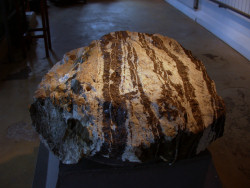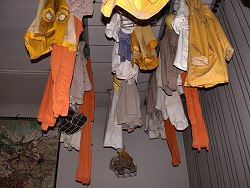Schachtanlage Knesebeck
Erzbergwerk Grund
Useful Information


| Location: |
Knesebeck 1, 37539 Bad Grund (Harz).
(51.8065969, 10.2431738) |
| Open: |
MAY to OCT Tue-Sun 11, 14. NOV to APR Sun 11, 14. Registration by telephone is recommended. [2025] |
| Fee: |
Adults EUR 9.50, Children (6-12) EUR 7, Children (0-5) free, Students (-26) EUR 7.50, School Pupils EUR 7.50, Disabled EUR 7.50, Family EUR 31. Groups (20+): Adults EUR 9, Children (6-12) EUR 7. [2025] |
| Classification: |
 Lead Mine Lead Mine
 Zinc Mine Zinc Mine
 Underground Power Plant Underground Power Plant
|
| Light: |
 Incandescent Incandescent
|
| Dimension: | T=8 °C. |
| Guided tours: | |
| Photography: | |
| Accessibility: | |
| Bibliography: | |
| Address: | |
| As far as we know this information was accurate when it was published (see years in brackets), but may have changed since then. Please check rates and details directly with the companies in question if you need more recent info. |
|
History
| 1564 | Hilff Gots im Grund first mentioned. |
| 1819 | Grube Bergwerkswohlfahrt started. |
| 1831 | Grube Hilfe Gottes started. |
| 1850 | Adit of a water course system started. |
| 1855 | Radstuben put into operation, Knesebeck shaft driven. |
| 1894 | Search tunnel excavated in the Eichelberg. |
| 1900 | Radstuben shut down. |
| 1912/13 | Hydrocompressor built. |
| 1923 | Erzbergwerk Grund is created by merging the ‘Hilfe Gottes’ and ‘Bergwerkswohlfahrt’ mines; Preussag AG takes over all state-owned mines in the western Harz region. |
| 1977 | Hydrocompressor shut down. |
| 1980 | The mining town of Bad Grund leases the site of the Knesebeck shaft from Preussag AG. |
| 30-NOV-1982 | Förderverein Bergbau- und Heimatmuseum e.V. Bad Grund (Association for the Promotion of the Mining and Local History Museum e.V.) Bad Grund founded. |
| 09-MAY-1982 | Museum officially opened. |
| 31-MAR-1992 | ‘Hilfe Gottes’ mine closed down. |
Geology
The Silbernaaler, Rosenhöfer and Laubhütter veins are part of the Upper Harz vein system and extend from the western edge of the Harz near Gittelde to the Clausthal plateau. The veins mainly run in an east-south-easterly direction. There were a total of seven veins of considerable thickness, which contained galena and zinc blende with an average metal content of 10 %. Lead, zinc, copper and silver were extracted from them. In total, around 16 million tonnes of ore were mined in the Grund ore mine, from which 1 million tonnes of lead, 700,000 tonnes of zinc and 2,500 tonnes of silver were extracted.
Description
The Knesebeck mine is located in Bad Grund, directly on the main road. It is a site with several buildings that are both a museum and a technical monument. These include a historic hoisting machine and a large electric compressor from 1923. Two wheelhouses contain water wheels with a diameter of 12 metres, which supplied the energy for the plant from 1855 to 1900. As they were out of service for so long and fell into disrepair, they had to be reconstructed.
There is also a rather unusual installation, the hydrocompressor tower. The 47 m high tower was used to produce compressed air for the mining industry and was powered by hydropower. From 1913 to 1977, it produced 660 m³ of compressed air per hour. The tower was needed to achieve the necessary drop height. This is due to the unusual design, which does not consist of a turbine and a compressor as one might assume. The system was much simpler and therefore much more robust. A water/air mixture fell from the top of the tower through a downpipe 100 metres below. There is a large pressurised tank in which the water and air separate again and which is therefore called an air separator. The water from the lower half of the tank is transported back to the top via a riser pipe, where it flows out in a tunnel. The air from the upper half drives the machines in the mine, mainly pneumatic hammers, as large percussion drills. In other words, the system has no moving parts and as long as the water supply is guaranteed, it continuously produces compressed air.
Due to its weight, water builds up a pressure of 1 bar per 10 metres of water column. There is a height difference of 64 metres from the surface of the earth to the air separator, so the air has a pressure of 6.4 bar. The water in the downpipe and in the riser are in equilibrium, and a further height difference is required to supply the system with the energy for the water to flow. The tower was responsible for this, in which there is a further 36 metres of downpipe, so that there is actually 10 bar on this side. The tower was supplied with water from the slope behind it, which flowed through communicating pipes. Overall, this system is one of many ingenious systems in the Harz Mountains in which mining was carried out using the power of water. The water was supplied by a network of canals, dams and tunnels. Such hydrocompressor towers were relatively rare in mining, the necessary height difference and the water requirement were quite difficult basic conditions. This is probably also the reason why this is the last existing plant of its kind in the world.
Mining in Bad Grund only came to an end in 1992 with the closure of the Hilfe Gottes mine, which was operated by Preussag AG. This marked the end of centuries of mining in the Harz Mountains. Like other mines in the Harz, it mined hydrothermal polymetallic deposits in veins. In other words, different metals were mined in different ratios.
The museum is known by various names, including the Knesebeck Mine Museum, the Knesebeck Shaft Mining Museum and the Bad Grund Mining Museum. It can only be visited as part of a guided tour. The normal guided tour takes place twice a day and includes the exhibition, the outdoor area, the hydrocompressor tower and two different tunnels. It is therefore not just a mining museum, but a show mine. You can learn about the technology of the last active mining industry in the Harz Mountains, but also about the historical development over 500 years.
 Search DuckDuckGo for "Schachtanlage Knesebeck"
Search DuckDuckGo for "Schachtanlage Knesebeck" Google Earth Placemark
Google Earth Placemark OpenStreetMap
OpenStreetMap
 Index
Index Topics
Topics Hierarchical
Hierarchical Countries
Countries Maps
Maps